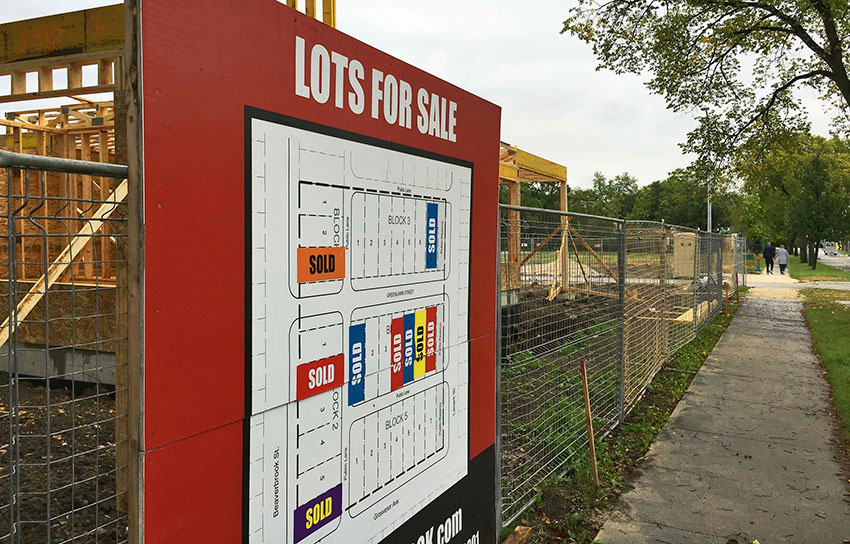
By Brent Bellamy, Creative Director and Architect
Republished with permission courtesy of the Winnipeg Free Press.
City's thirst for growth fees ignores their power as a planning tool
For the last 50 years, Winnipeg’s built-up geographic area has been increasing at a rate of more than twice the city’s population growth. There are 20 per cent fewer people living in River Heights today than in 1970. In Wolseley, the population is down 36 per cent, St. Boniface 23 per cent and even busy Osborne Village has seen a population decline of 11 per cent during that time. Image: (Supplied / Winnipeg Free Press) An infill project in River Heights: the city should use a carrot-and-stick approach with growth fees to discourage sprawl and encourage projects that improve population density, Brent Bellamy writes.
Image: (Supplied / Winnipeg Free Press) An infill project in River Heights: the city should use a carrot-and-stick approach with growth fees to discourage sprawl and encourage projects that improve population density, Brent Bellamy writes.
The city’s population density is lower today than it has ever been — and it continues to drop. We want to live large. The average new Canadian home size, growing to almost 2,000 square feet today from 1,050 square feet in 1975, is a clear indication we like space.
Why does it matter? Shouldn’t we be free to live wherever we want?
The difficult reality is that low population density has had a significant effect on the economic viability of our city. Sprawling growth is at the root of almost everything we complain about: taxes, city services, potholes and traffic. Only mosquitoes and winter seem exempt from its effects.
Lower density means there are fewer taxpayers paying for every kilometre of road and sewer line, every bridge, community centre, library and water treatment plant. Each property owner in Winnipeg today is financially responsible for maintaining a greater share of the city’s services and infrastructure than ever before. Each tax dollar we give up must clear snow from a greater length of road and fill more potholes than it did when we lived in higher density neighbourhoods. The results are manifested in our moonscape roadways.
With few mechanisms for raising revenue to cover the fiscal shortfall caused by sprawling growth, the City of Winnipeg has begun the controversial process of introducing growth development charges. These tariffs attempt to recoup the associated infrastructure costs of new development. The basic principle is that the financial impact of growth should pay for itself and not be transferred to the existing tax base.
The most commonly identified target of growth fees are large suburban subdivisions. Generally, their remote locations, disconnected layouts and lower densities are inefficient for transit use and often require all new amenities and infrastructure to be built.
Developers will argue that fees are not justified because they already pay for the infrastructure within new subdivisions and part of the connections to it. Cost-benefit studies submitted for larger subdivisions often show new tax revenue will be a boon to the city. While this may be true if new development is viewed as an island, when the effects on infrastructure outside new developments are included, the impact on the city as a whole is not sustainable. New subdivisions soon demand costly road widening, flyovers and underpasses that quickly eat away at any profit the city makes on new taxes within the development.
The economic impact of reduced density has led most cities to implement planning policy that encourages more efficient, compact development that integrates closely into existing community and retail amenities, public services and infrastructure.
Winnipeg is no different. Higher density is a clear goal of the Our Winnipeg plan. Investments such as rapid transit and even bike lanes are not simply about cutting a few minutes off a morning commute. They are key strategies to guide more compact, new suburban development. Tax incentives, parking requirements, neighbourhood plans and zoning allowances are being tailored to promote infill growth and higher-density neighbourhoods across the city.
If structured effectively and implemented in close consultation with the city’s planning department, the proposed growth development charges could be another powerful tool to help meet these density objectives. Tailoring fees can have a significant effect on land use, guiding the location and form of new development.
Growth development charges in many cities use an area-specific pricing framework to more closely reflect the true long-term impact on infrastructure costs and influence growth patterns to meet planning objectives. Land that is farther from the city centre and existing infrastructure, or in less desirable development areas as identified in growth plans, is charged higher fees to incentivize more efficient land use and encourage a more compact city form.
Currently, the infill development that is so vital for increasing overall urban density, faces far greater economic challenges than open sites on the fringes of the city. Higher construction and land costs, parking requirements and lengthy, uncertain approval processes that often face community opposition deter developers from investing in existing neighbourhoods. Growth fees can — and should — be used to level the playing field on these expenses by eliminating or significantly reducing charges on infill growth while at the same time, creating a fee structure for isolated development that is a more appropriate reflection of the long term costs to the city.
It is also important for growth charges to promote higher density and mixed uses within new developments. Many cities will use a density gradient to establish a fee structure that rewards higher density development and encourages more compact growth patterns that reduce infrastructure requirements and make transit systems more viable.
A blanket approach to development fees, charging by square metre or number of units, regardless of location or impact, would further disadvantage the tenuous development economics of infill growth and provide even more incentive to search out easier, remote development opportunities.
Earlier this year, the City of Winnipeg implemented new rezoning fees, using a blanket approach for all project sizes and types. The result was to disproportionately punish smaller projects and create disincentives for infill growth. Development fees will have an even greater impact on the difficult economics of investing in existing neighbourhoods, so it is vital that the approach is more nuanced to align with planning goals.
Growth charges are not the solution to suburban sprawl, they are a reaction to it. If we want to get out from under the economic burden of low density, we must use every mechanism possible to guide development into smarter growth for the long term. Rising construction costs mean development charges will have to continually grow to keep pace with infrastructure costs, unless we simultaneously focus on building a more sustainable city form.
Opposition to new government fees is natural, but the reality is the sprawling growth of our city has caught up to us. Our roads are crumbling, taxes are rising and services are being cut. The only long-term solution is to build a higher density, more compact city. It is understandable, however, that the government is searching for immediate revenue sources to cover our expanding $7-billion infrastructure deficit.
If development fees are to be implemented, they should not only be seen as a financing tool, but also recognized as a powerful planning tool. It will be important that the city and province work together to create mechanisms flexible enough to allow incentives for infill and higher density growth, while at the same time curbing the city’s outward expansion, to help make Winnipeg a more financially sustainable and prosperous city
Brent Bellamy is creative director at Number Ten Architectural Group.
bbellamy@numberten.com

